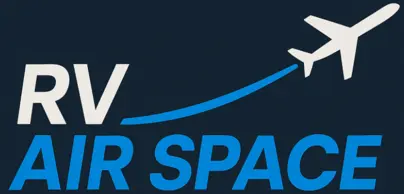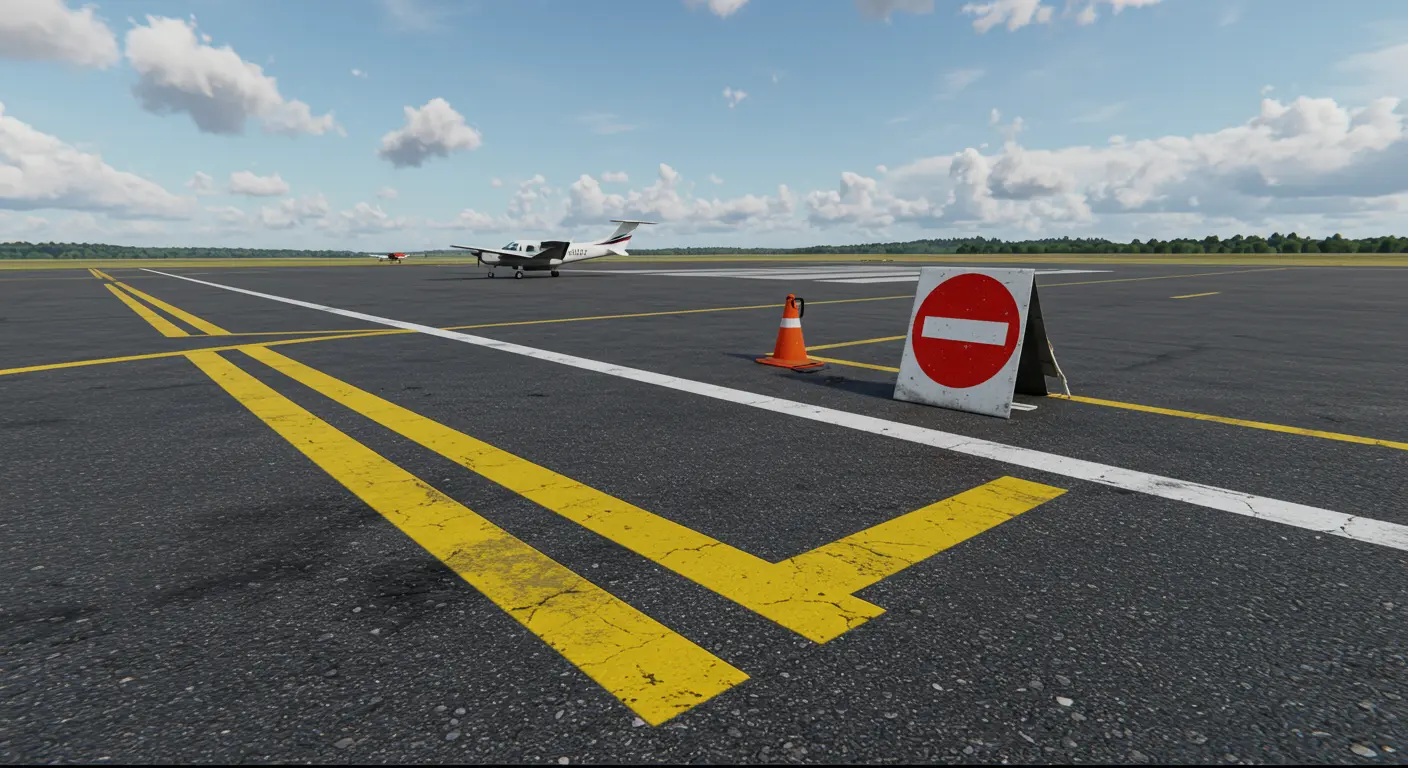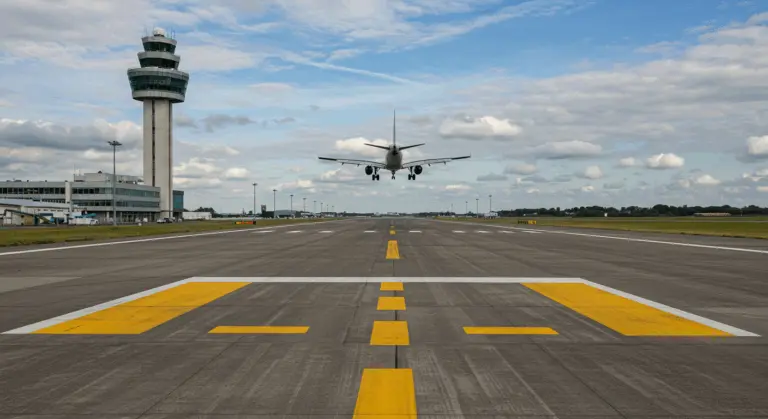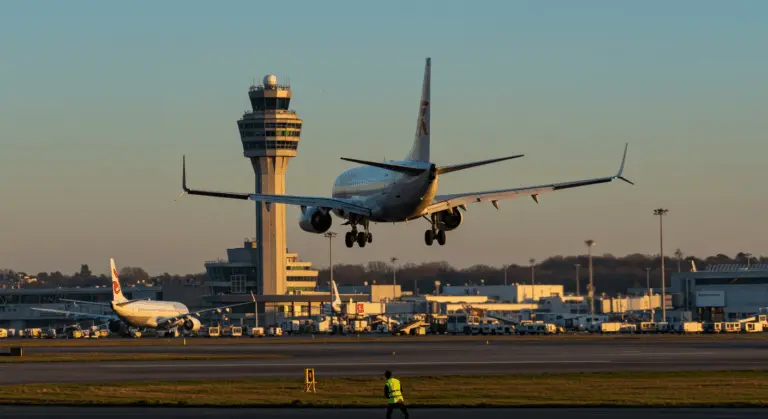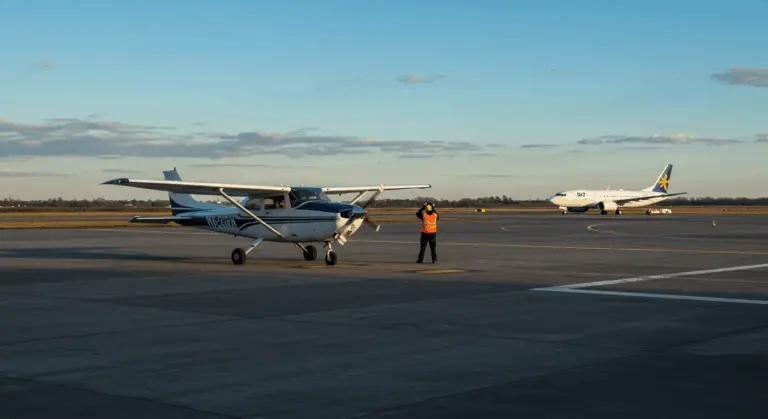Airport Signs and Markings Quiz – Test Your Knowledge
Understanding Airport Signs and Markings
Airport markings form an intricate visual language—a sophisticated system of symbols, lines, and colors painted across runways, taxiways, and aprons. These markings serve as essential navigational aids, guiding both pilots and ground personnel while clearly defining operational boundaries and specialized zones throughout the airfield.
Mastering these markings is essential for maintaining situational awareness, particularly when operating at sprawling, complex airports. Understanding these markings allows pilots to navigate confidently from parking areas to active runways, interpreting the comprehensive visual system that orchestrates efficient airport operations.
Runway markings and signs provide clear guidance for takeoff, landing, and taxiing. They include critical information like distance remaining signs and threshold markings, supporting proficient ground navigation and effective airport safety protocols.
Types of Airport Signs
Airport signs and markings are divided into four distinct categories:
-
Runway Markings: White markings including thresholds, designation numbers, centerlines, and aiming points to guide pilots on runways.
-
Taxiway Markings: Yellow markings such as centerlines, edge lines, and hold short lines for guiding aircraft during ground movement.
-
Holding Position Markings: Critical safety lines indicating where aircraft must stop before entering a runway or intersection.
-
Other Markings: Various indicators like vehicle roadway markings and apron boundaries that support overall airport operations.
A standardized color system ensures universal recognition across all airports worldwide:
Quiz: Test Your Knowledge on Airport Markings
Challenge your understanding of airport signs and markings with our comprehensive quiz. Created for both student and seasoned pilots, it covers the critical visual cues essential for safe taxiing at complex airports. The focus? Standard signage that guides aircraft from parking positions to active runways.
The quiz covers essential markings every pilot must instantly recognize—runway designators, taxiway indicators, and holding position markings. Why does this matter? Mastering these visual elements builds confidence and situational awareness needed for navigating complex airports.
The quiz also includes practical application scenarios covering:
-
Comparing airport locations with nearby charted towns.
-
Identifying airport beacons.
-
Supplementing visual approaches with instrument guidance.
-
Properly interpreting airport diagrams.
-
Understanding pilot-controlled lighting systems.
-
Recognizing approach light configurations.
-
Avoiding common visual illusions.
This quiz is valuable for check ride preparation, venturing to unfamiliar airports, or simply maintaining peak proficiency. Sharpen your ground operation skills and improve airport navigation skills through practice.
Sample Questions from the Quiz
Here’s a glimpse of the questions you’ll find in our quiz:
-
Question: Which sign indicates the direction and designation of intersecting taxiways?
-
Answer: Directional Sign. These yellow signs with black text help pilots identify connecting taxiways.
-
Question: What color are runway edge markings?
-
Answer: White. This color distinguishes runways from taxiways, which have yellow markings.
-
Question: What does a No Entry Sign indicate?
-
Answer: An area where aircraft are prohibited from entering. These signs have a red background with a white bar and are vital for preventing runway incursions.
Beyond basic recognition, the quiz includes scenario-based questions that test practical application. For example, identifying holding positions at complex intersections under time pressure. These realistic challenges ensure you can confidently apply theoretical knowledge in demanding real-world situations.
Key Airport Markings to Know
Understanding key airport markings is essential for safe navigation. Here are the most critical markings every pilot must recognize without hesitation:
-
Runway Designators: Large white numbers at the runway end indicating its magnetic heading (e.g., “27” for 270°), crucial for confirming the correct runway.
-
Centerline and Edge Markings: White lines on runways and yellow lines on taxiways provide path guidance and visually distinguish between these different operational areas.
-
Holding Position Markings: Distinctive yellow lines (two solid, two dashed) paired with red signs, indicating where aircraft must stop before entering a runway to prevent incursions.
-
Threshold and Aiming Point Markings: White stripes mark the runway’s beginning (threshold), while two broad white rectangles 1,000 feet from the threshold serve as a visual touchdown target (aiming point).
-
Enhanced Taxiway Centerline Markings: Dashed yellow lines with black borders on either side that provide an additional visual cue when approaching a runway holding position.
Runway Safety Signs
Runway safety signs are designed to prevent serious incidents. Instantly recognizable by their bold red background and crisp white text, these signs communicate mandatory instructions. They’re positioned at runway holding positions, ILS critical areas, and approach zones.
Their purpose is controlling ground traffic flow and positioning aircraft before runway entry. These signs work together with holding position markings, creating multiple layers of visual warnings that reduce runway incursion risks—one of aviation’s most serious safety threats.
Once on the runway, signs continue providing vital operational information. Distance remaining signs— black numbers displayed against white backgrounds. They indicate remaining runway length in thousands of feet, which are valuable for critical takeoff and landing decisions.
These signs help prevent common runway safety incidents, including:
-
Runway Excursions: Veering off the runway surface.
-
Overruns: Continuing beyond the runway end.
-
Incursions: Unauthorized entry onto a runway.
-
Confusion: Mistaking one runway for another.
-
Undershoots: Landing short of the runway threshold.
Resources for Learning About Airport Signs
Many resources are available to help pilots master airport signage systems. The Federal Aviation Administration (FAA) provides, offering comprehensive educational materials including interactive quizzes and detailed flashcards. These resources cover critical visual cues—from holding position signs to closed runway indicators—all designed to prevent dangerous incursions.
Quizlet improves sign learning through digital flashcards, enabling self-paced study sessions. Pilots can learn essential signs like runway locators and mandatory instruction markers. The platform’s intelligent spaced repetition system improves learning by focusing on more challenging signs.
Sheppard Air provides airfield familiarization through their quick guidance quiz—perfect for check ride preparation or transitioning to unfamiliar, complex airports. This tool specifically tests recognition speed and accuracy. These skills are important for navigating busy airports.
Together, these diverse tools improve situational awareness during ground operations. Regular, practice helps pilots develop the instantaneous pattern recognition needed to interpret visual cues without hesitation. This reduces cognitive load during taxiing and runway operations when mental resources are already stretched thin.
Interactive Learning Tools
Interactive digital platforms—quizzes, flashcards, and sophisticated mobile apps—make learning airport signs more engaging. These tools enable pilots to practice identification and interpretation within realistic yet pressure-free environments.
Immediate feedback creates a powerful, rapid learning loop that speeds up proficiency development. Consider the FAA’s advanced digital platform: it employs simulation-based exercises where users navigate virtual airports, responding to dynamic signage scenarios in real-time.
Today’s most sophisticated mobile applications go further. They feature augmented reality training modules and progressive difficulty levels. Users advance from basic markings to challenging scenarios involving construction zones or non-standard airport layouts that test even experienced pilots.
